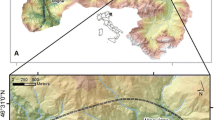Abstract
Here the vulnerability is defined as the potential total maximum losses due to a debris flow damaging event for a specific debris flow fan. The vulnerability is classified into property vulnerability and population vulnerability. Assessment indexes include the assets of buildings, traffic facilities, lifeline works, personal properties, and land resources for property vulnerability; age, education, and wealth of the inhabitants, natural population growth rate, and population density for population vulnerability. The vulnerability is expressed as the sum of the transformed values of the losses of property and population. Two study cases with post-fact damages by historic debris flow events in Sichuan of SW China are presented.
Similar content being viewed by others
References
Alexander D.E. 2005. Vulnerability to Landslides. In: Glade T., Anderson M.G. and Crozier M.J. (eds.), landslide and risk. Wiley. Pp. 175–198.
Bell R. and Glade T. 2004. Quantitative Risk Analysis for Landslide — Examples from Bildudalur, NW Iceland. Natural Hazards and Earth System Sciences 4: 117–131
Blaikie P., Cannon T,, Gavis I. and Wisner B. 1994. At Risk: Natural Hazards, People’s Vulnerability, and Disasters. London, Routledge. Pp. 284.
Cutter S.L., Boruff B.J. and Shirley W.L. 2003. Social Vulnerability to Environmental Hazards. Social Science Quarterly 84(2): 242–261.
Einstein H.H. 1997. Landslide Risk Systematic Approaches to Assessment and Management. In: Cruden DM, Fell R (eds.), Landslide Risk Assessment. Rotterdam, A.A. Balkema. Pp. 25–50.
Hufschmidt G., Crozier M. and Glade T. 2005. Evolution of Natural Risk: Research Framework and Perspectives. Natural Hazards and Earth System Sciences 5: 375–387.
Lavigne F., Thouret J.C., Voight B., Suwa H. and Sumaryono A. 2000. Lahars at Merapi Volcano, Central Java: Overview. Journal of Volcanology and Geothermal Research 100: 423–456.
LIU X and LEI J. 2003. A Method for Assessing Regional Debris Flow Risk: an Application in Zhaotong of Yunnan Province (SW China). Geomorphology 52(1–2): 181–191.
LIU X and MO D. 2003. Risk Assessment on Debris Flow. Chengdu, Sichuan Science and Technology Publishing House. Pp 104. (In Chinese)
LIU X., YUE Z. H., Tham L. G. and Lee C. F. 2002. Empirical Assessment of Debris Flow Risk on a Regional Scale in Yunnan Province, Southwestern China. Environmental Management 30(2): 249–264.
LUO Y., ZHANG L. and ZHANG Y. 1998. Estimation Method of Geological Risk. Beijing, Geological Press. Pp 116. (In Chinese)
Ngo E. B. 2001. When Disasters and Age Collide: Reviewing Vulnerability of the Elderly. Natural Hazards Review 2(2): 80–89.
Panizza M. 1996. Environmental Geomorphology. Amsterdam, Elsevier, Pp. 268.
Solway L. 1999. Socio-economic Perspective of Developing Country Megacities Vulnerable to Flood and Landslide Hazard. In: Casale R & Margottini C (eds.), Floods and Landslides: Integrated Risk Assessment. Berlin, Springer-Verlag. Pp. 245–260.
Tiedemann H. 1999. The Economical Consequences of Floods and Landslides. In: Casale R & Margottini C (eds.), Floods and Landslides: Integrated Risk Assessment. Berlin, Springer-Verlag. Pp. 223–244.
Tobin G. and Montz B. E. 1997. Natural Hazards: Explanation and Integration. New York, The Guilford Press. Pp. 388.
United Nations, Department of Humanitarian Affairs. 1992. Internationally Agreed Glossary of Basic Terms Related to Disaster Management, DNA/93/36, Geneva. Pp. 1–6.
Weichselgartner J. 2001. Disaster Mitigation: the Concept of Vulnerability Revisited. Disaster Prevention and Management 10(2): 85–94.
Woo G. 1999. The Mathematics of Natural Catastrophes. London, Imperial College Press. Pp. 292.
XIE H and ZHONG D. 1990. Debris Flow Disasters and Characteristics in Zili gully. Mountain Research 8: 114–117. (In Chinese)
Author information
Authors and Affiliations
Rights and permissions
About this article
Cite this article
Liu, X. Site-specific vulnerability assessment for debris flows: Two case studies. J. Mt. Sci. 3, 20–27 (2006). https://doi.org/10.1007/s11629-006-0020-1
Received:
Accepted:
Issue Date:
DOI: https://doi.org/10.1007/s11629-006-0020-1




